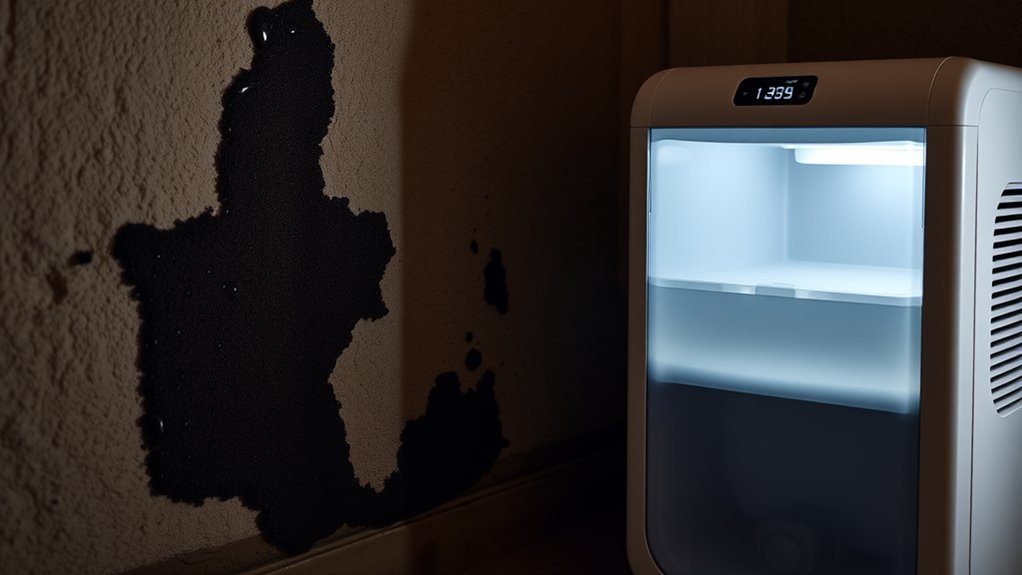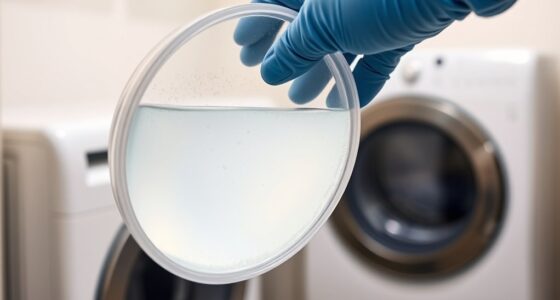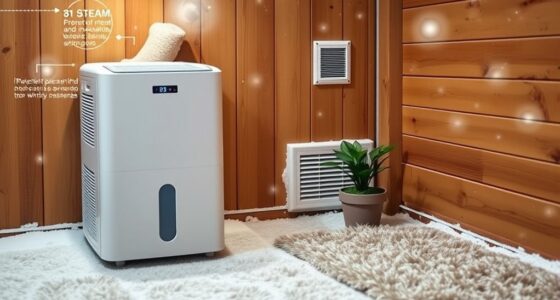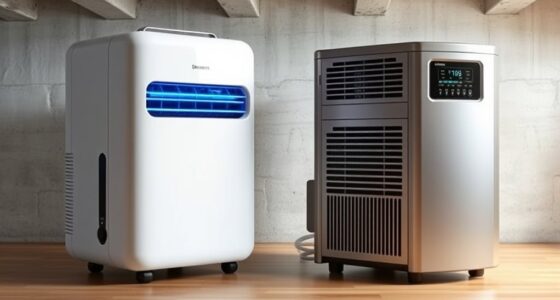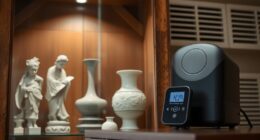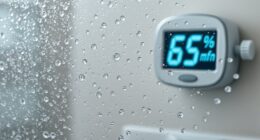To prevent black mold, you should use dehumidifiers to keep indoor humidity between 30-50%, as molds thrive in damp environments. Place them in trouble spots like basements and bathrooms, and make sure to empty and clean them regularly. Fix leaks, improve air circulation, and eliminate moisture sources promptly. Keeping moisture levels controlled is your best defense; continue to explore effective strategies for a healthier home environment.
Key Takeaways
- Use dehumidifiers to maintain indoor humidity between 30-50%, inhibiting mold growth.
- Place dehumidifiers in damp areas like basements and bathrooms for targeted moisture control.
- Combine dehumidifiers with proper ventilation, exhaust fans, and regular airflow to reduce moisture accumulation.
- Fix leaks and eliminate water sources promptly to prevent mold spores from settling and growing.
- Monitor humidity levels with a hygrometer and perform routine maintenance to ensure effective mold prevention.
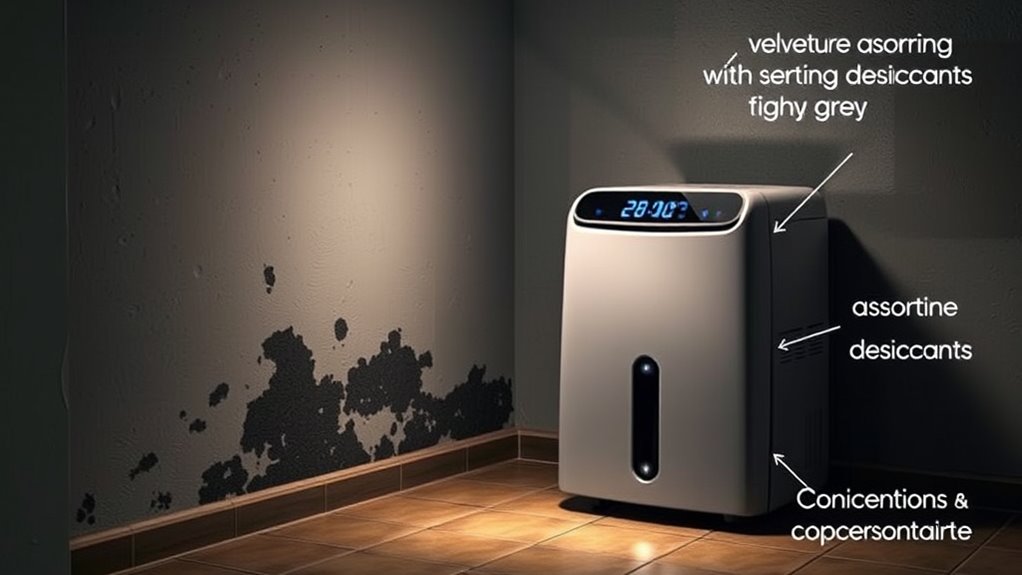
Black mold thrives in damp environments, making humidity control vital for preventing its growth. When you focus on maintaining good air quality in your home, you reduce the chances of mold spores settling and multiplying. Mold needs moisture to thrive, so controlling moisture levels is your first line of defense. Using a dehumidifier helps you keep indoor humidity between 30-50%, an ideal range for mold prevention. When humidity levels stay within this range, you create an environment that’s less inviting for mold growth, reducing health risks and property damage.
Controlling indoor humidity with a dehumidifier prevents black mold growth and protects your health and home.
Air quality plays a major role in preventing black mold. Poor air circulation and high humidity give mold spores a perfect environment to settle and grow. Investing in a dehumidifier not only reduces moisture but also improves overall air quality by removing excess dampness that fosters mold development. It’s important to place your dehumidifier in areas prone to dampness, such as basements, bathrooms, or laundry rooms. Regularly emptying the water reservoir and cleaning the unit ensures it functions effectively. Additionally, using exhaust fans or opening windows can supplement moisture control efforts, especially in humid weather, ensuring good air circulation. Better air quality means fewer mold spores linger in the air, lowering the likelihood of mold taking hold.
You should also address sources of excess moisture, such as leaks, condensation, or damp clothing. Fixing leaks promptly prevents water from seeping into walls or floors, which can create ideal mold conditions. Using a dehumidifier along with other moisture control strategies amplifies your efforts, making your environment less hospitable for mold. Keep an eye on humidity levels with a hygrometer, so you know when to turn up your dehumidifier or take additional measures. It’s equally important to keep surfaces dry and clean, especially in areas prone to moisture buildup. Regularly inspecting these spaces helps catch problems early before mold can establish itself. Proper moisture management is a cornerstone of effective mold prevention.
In essence, maintaining excellent air quality and moisture control through the consistent use of a dehumidifier greatly reduces your risk of black mold. By managing humidity levels, improving air circulation, and addressing water sources, you create an inhospitable environment for mold spores to thrive. These simple, proactive steps not only protect your health but also preserve your home’s integrity. The key is staying vigilant and making moisture management a routine part of your home maintenance. With these strategies, you can effectively prevent black mold growth and enjoy a safer, healthier living space.
Frequently Asked Questions
Can Dehumidifiers Eliminate Existing Black Mold Completely?
A dehumidifier alone can’t completely eliminate existing black mold. While it helps reduce moisture, you still need proper mold remediation techniques to fully remove mold spores. Regular dehumidifier maintenance, like cleaning filters, guarantees it works effectively. To address black mold, combine dehumidification with thorough cleaning and professional treatment if needed. This combined approach prevents mold from returning and keeps your space healthier.
How Often Should I Clean My Dehumidifier to Prevent Mold?
You should clean your dehumidifier at least once a month to prevent mold growth. Follow proper maintenance routines by regularly emptying and drying the water tank, wiping down filters, and inspecting for mold or mildew. Replace filters as recommended by the manufacturer, usually every few months. Keeping your dehumidifier clean and maintaining it properly guarantees it functions efficiently and helps prevent mold from developing inside the unit.
Are There Specific Dehumidifier Features That Inhibit Mold Growth?
Are there features that fight fungus? Yes! Look for dehumidifiers with humidity control for precise dryness, and filter efficiency to trap mold spores. Features like antimicrobial coatings on coils and easy-to-clean filters help inhibit mold growth. You’ll want a device that’s designed to detect and maintain ideal humidity levels, reducing moisture that mold loves, and ensuring cleaner, healthier air in your space.
Can Dehumidifiers Be Used Safely in Allergy-Sensitive Households?
Yes, you can safely use dehumidifiers in allergy-sensitive households. Make sure to choose a mold-resistant model with a good air purifier feature, which helps remove allergens and mold spores from the air. Regularly clean the dehumidifier to prevent mold growth inside it. Using a combination of a dehumidifier and an air purifier creates a healthier environment, reducing allergy triggers and keeping mold at bay.
What Are the Signs My Dehumidifier Is Failing to Prevent Mold?
If your dehumidifier isn’t preventing mold, look for signs like persistent humidity, a musty smell, or visible mold spots. Regular dehumidifier maintenance, like cleaning filters and checking for leaks, is vital. Use mold detection methods such as moisture meters or inspection for condensation buildup. If these signs appear, it’s time to troubleshoot or replace your device to guarantee it effectively keeps moisture levels low and prevents mold growth.
Conclusion
By now, you see how effective dehumidifiers can be in preventing black mold growth. Regular use and proper maintenance keep humidity levels in check, safeguarding your home and health. But aren’t you worth the extra effort to create a safer, mold-free environment? Taking proactive steps today means fewer worries tomorrow. Don’t wait until mold takes hold—embrace these strategies and breathe easier, knowing you’ve done all you can to protect your space.
